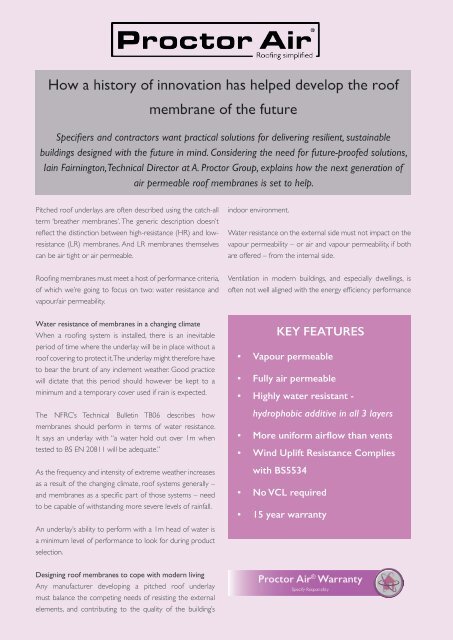February 2024
Create successful ePaper yourself
Turn your PDF publications into a flip-book with our unique Google optimized e-Paper software.
How a history of innovation has helped develop the roof<br />
membrane of the future<br />
Specifiers and contractors want practical solutions for delivering resilient, sustainable<br />
buildings designed with the future in mind. Considering the need for future-proofed solutions,<br />
Iain Fairnington, Technical Director at A. Proctor Group, explains how the next generation of<br />
air permeable roof membranes is set to help.<br />
Pitched roof underlays are often described using the catch-all<br />
term ‘breather membranes’. The generic description doesn’t<br />
reflect the distinction between high-resistance (HR) and lowresistance<br />
(LR) membranes. And LR membranes themselves<br />
can be air tight or air permeable.<br />
indoor environment.<br />
Water resistance on the external side must not impact on the<br />
vapour permeability – or air and vapour permeability, if both<br />
are offered – from the internal side.<br />
Roofing membranes must meet a host of performance criteria,<br />
of which we’re going to focus on two: water resistance and<br />
vapour/air permeability.<br />
Ventilation in modern buildings, and especially dwellings, is<br />
often not well aligned with the energy efficiency performance<br />
Water resistance of membranes in a changing climate<br />
When a roofing system is installed, there is an inevitable<br />
period of time where the underlay will be in place without a<br />
roof covering to protect it. The underlay might therefore have<br />
to bear the brunt of any inclement weather. Good practice<br />
will dictate that this period should however be kept to a<br />
minimum and a temporary cover used if rain is expected.<br />
The NFRC’s Technical Bulletin TB06 describes how<br />
membranes should perform in terms of water resistance.<br />
It says an underlay with “a water hold out over 1m when<br />
tested to BS EN 20811 will be adequate.”<br />
As the frequency and intensity of extreme weather increases<br />
as a result of the changing climate, roof systems generally –<br />
and membranes as a specific part of those systems – need<br />
to be capable of withstanding more severe levels of rainfall.<br />
An underlay’s ability to perform with a 1m head of water is<br />
a minimum level of performance to look for during product<br />
selection.<br />
KEY FEATURES<br />
• Vapour permeable<br />
• Fully air permeable<br />
• Highly water resistant -<br />
hydrophobic additive in all 3 layers<br />
• More uniform airflow than vents<br />
• Wind Uplift Resistance Complies<br />
with BS5534<br />
• No VCL required<br />
• 15 year warranty<br />
Designing roof membranes to cope with modern living<br />
Any manufacturer developing a pitched roof underlay<br />
must balance the competing needs of resisting the external<br />
elements, and contributing to the quality of the building’s
















